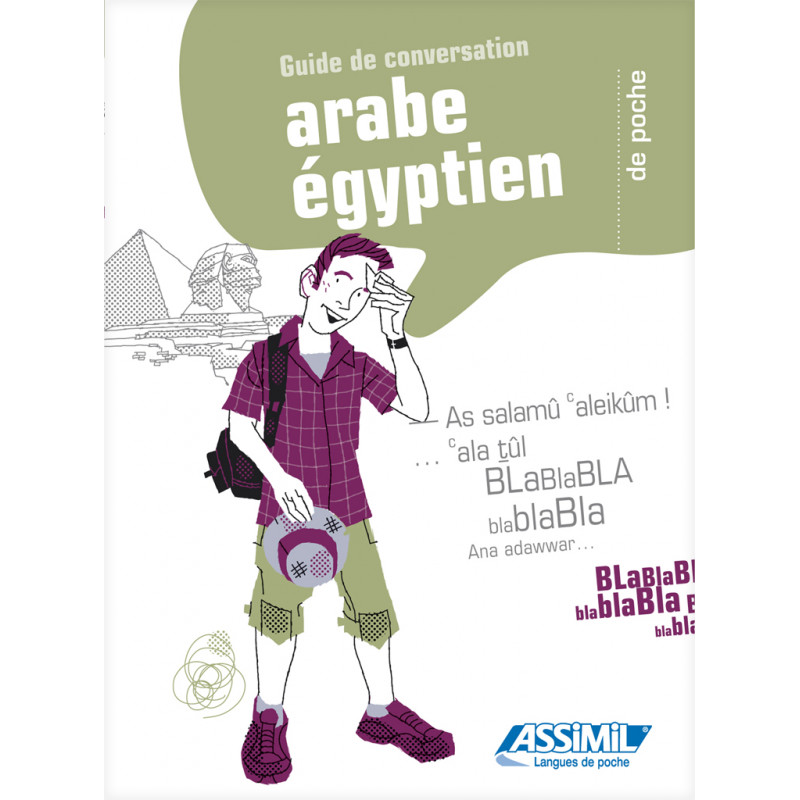


Promotions SANA: Jusqu’à -20%, Cliquez ici
Promotions SANA: Jusqu’à -20%, Cliquez ici
The Arabic spoken in Egypt is relatively simple and widely understood in the Arab world. To navigate tourism-related situations, this phrasebook walks you through key words, basic grammar, useful phrases, and common expressions. A lexicon of more than 2,000 words gives you all the vocabulary you need for your trip.
An original and easy conversation guide containing:
A grammar section to introduce you to the structures of the language and teach you how to construct your own sentences.
A conversation part to communicate easily thanks to key words and standard phrases divided into 60 thematic headings containing the essential vocabulary of the language, supplemented by a lexicon of more than 2,000 words.
The pronunciation of all words and phrases in Egyptian.
Author: Hans-Günter Semsek
Adapter: Nagwa Hassan
Features: Phrasebook
(A 160-page guide)
ISBN: 9782700505238
Level: All levels
Arabic is spoken today_by more than 300 million people in the world. Vmgt-two states have adopted it as their official language and, from Morocco to the Comoros, their inhabitants can communicate from one country to another without difficulty. Alongside the vernacular - Moroccan dialect, Berber, African languages, etc. - which is their daily means of expression, all those who are able to follow a radio or television broadcast, or better still to read the press, are likely to speak what will be called "unified modern Arabic". A foreigner using this language will therefore be able to make himself understood everywhere in the Arab world, except perhaps in the most remote corners of the Arabic-speaking territories, where the media have little impact. He must also insist that his interlocutors use the same language in return. Arabic has another advantage, it is to have crossed the centuries without profound changes, which allows any Arabic speaker to access texts 1000 years old, or even older. An Arabic text from the 9th century of the Christian era will be much more easily readable and understood by an Arab of today than the Essays of Montaigne, however from the 16th century, by a Frenchman. Only the vocabulary, which is very rich and has fallen into disuse, will require the use of a dictionary from time to time. One can therefore read verses from the Koran, whose consignment in writing on various media has made it possible to fix this language from the first centuries of the Hegira, a time when Arabic became a sacred language as a vehicle of the prophetic message. Arabic is a Semitic language, close to Aramaic and Hebrew, with which it shares the same type of consonant structure. It was above all an oral language, the Arabs excelling in oratory and poetic contests. The transmission of knowledge and culture was essentially carried out by way of oral tradition, the use of writing not yet having spread in northern Arabia. The current Arabic alphabet was born from the borrowing and modification of Nabataean characters (Arab tribe of the kingdom of Petra, between the 1st century BC and the 2nd century AD), themselves derived from the 'Aramaic. If the Arabic script and the structure of the Arabic language are intimately linked - this is why we cannot dissociate learning from it - this is not the case when other languages borrow the Arabic alphabet. Indeed, any text written in Arabic characters is not necessarily Arabic and, on the other hand, Arabic writing is not always well suited for the notation of a language that is neither Arabic nor even Semitic. This was the case until the beginning of the 20th century with Ottoman (Turkish, of Ural-Altaic origin, mixed with Persian), which was the language of the empire of the same name. And it is still the case today. hui from Persian and Ur Dou, Indo-European languages. After the Arab conquest and the extension of the Islamic world, all the countries converted to the new religion - from Spain to the borders of India - adopted Arabic as their main language and especially in the fields of science and of theology, a phenomenon that persisted until the 16th century throughout the Mediterranean basin. Since modern times, Arabic - contrary to what is sometimes claimed - has been able to show great flexibility in adapting to the evolution of the world and creating neologisms responding to new concepts and new technologies. . Currently, there is a distinction between North African Arabic and Eastern Arabic (including mainly Syra-Egyptian), each branch grouping together the many dialects of the countries of these two large territorial areas. Modernized Literal Arabic is the language that linguistically and culturally unifies all these countries.
Data sheet
Specific References
No customer reviews for the moment.